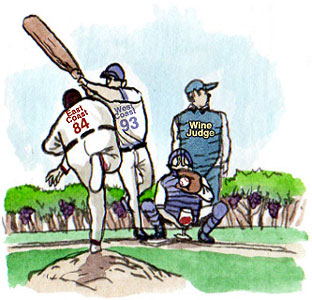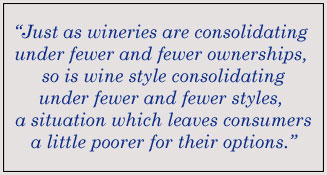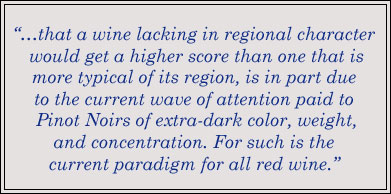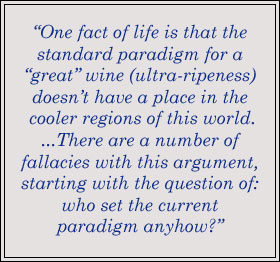

Wine judges and critics accustomed to the heavy hitting,
big lumber style of the West Coast often miss the subtly
and finesse of a well pitched East Coast wine.
East Coast Greatness: Subtle wines that speak volumes about place
"We cherish the regional differences between St. Julien, Margaux, and St. Estèphe, why do we not also honor the differences between Napa and Finger Lakes?"
by
Dan Berger
September 6, 2006
One of the most pernicious aspects of rating wines by numbers is that it establishes a rather narrow spectrum of what is seen as great wine.
Just as wineries are consolidating under fewer and fewer ownerships, so is wine style consolidating under fewer and fewer styles, a situation which leaves consumers a little poorer for their options. The style seen as most appropriate for almost all red wines is big and chewy, with bigness almost an essential component for a very high score. Delicacy is de-rewarded.
The style seen as most appropriate for almost all red wines is big and chewy, with bigness almost an essential component for a very high score. Delicacy is de-rewarded.
This, oddly enough, applies equally to Cabernet Sauvignon, Cabernet Franc, Pinot Noir and Chianti, even though three of those wines were traditionally made to emphasize other elements. Chewiness was not an essential component for them in the 1980s and prior to that decade, and thus greatness was rarely ascribed only to a single style in such wines. Today, without a “hit” of oak, a “wallop” of intensity, or gobs of fruit, a wine is discarded as wimpy. Sounds a bit like a Batman cartoon -- oof.
Take Burgundy as one example. Fifty or a hundred years ago, purists who bought Burgundy were looking for elements in the wine which expressed its terroir, with an understanding that some districts simply did not usually make a great wine.
In those days, the regions of Volnay, Monthelie, Auxey-Duresses, and Saint Romain rarely made a “classic” red wine, and such was the tenor of the land nearby that Meursault and Puligny-Montrachet were almost entirely white wine districts.
When you encounter a fine Volnay or even Santenay today, they can be superb expressions of their soil, despite their more refined nature, and some say they represent great value. Yet their scores usually reflect their relative delicacy. They are not usually big wines.
And when one of them turns out to be bigger than the normal district paradigm? Well, the scores rise! Even though the wine lacks the typicité, as the French would say.
 That curious fact - that a wine lacking in regional character would get a higher score than one that is more typical of its region, is in part due to the current wave
of attention paid to Pinot Noirs of extra-dark color, weight, and concentration. For such is the current paradigm for all red wine. The above-named Burgundy districts can make wines of such intensity only with assistance from science, or addition of fruit from other regions.
That curious fact - that a wine lacking in regional character would get a higher score than one that is more typical of its region, is in part due to the current wave
of attention paid to Pinot Noirs of extra-dark color, weight, and concentration. For such is the current paradigm for all red wine. The above-named Burgundy districts can make wines of such intensity only with assistance from science, or addition of fruit from other regions.
Clearly, Santenay and Volnay and many other reds from Burgundy can be made weighty and powerful by illegal or unethical means. But a perfectly made wine from such “lighter districts” can still display a substance in the mid-palate and a body that is belied by its paler color.
The reasonable pricing for many of these wines, even those which are the best of their respective regions, makes it seem that they are of lesser quality. But lovers of these lighter wines of France are passionate about them in ways that the “big” wine lovers rarely understand.
I first learned about this passion at a trade tasting in Los Angeles in 1979. One particular Volnay from 1976 was darker than its compatriots. At the table where it was being poured, a rather snobbish and officious fellow crowed about how the wine was so rich and powerful. To which, another older taster replied, “Yeah, and that’s not Volnay.”
A heated discussion ensued, in which the older gentleman suggested that this particular wine was a blunt, crude, and coarse example of red wine and completely atypical of Volnay. He admitted that, yes, the wine was deeper than most of the Volnays we had been offered, but in its weight and concentration, it was a poor example of its terroir.
The younger man, undeterred, asked his challenger if he wanted a “thin, watery” Volnay or one with richness. It was clear that the older man’s argument was lost in the weight and density of the wine that was named Volnay, but to which it had no real connection.
I thought of this conversation years later, when Rob Davis, winemaker at Jordan (and the hand-picked choice of Andre Tchelistcheff as Jordan’s winemaker) told me a story about the master’s view of a particularly elegant Pinot Noir.
At the time, Davis was a fresh-out-of-school enology graduate. “Andre asked me to describe the wine,” said Rob, “and I began to fumble around for words like fruit and oak. Then Andre simply said, ‘It’s like a beautiful young woman wrapped in fur.’”
The subtlety of such wines is one of their raisons d’etre, but this means, unfortunately, that they will score less points with some people. I could tell that from the demeanor of that young snob 27 years ago, and I continue to see it in the almost knee-jerk high scores awarded to some wines that are hollow: mostly oak, alcohol and with no varietal character.
Which leads us to the topic of this seminar: the uniqueness of East Coast red wines, and their validity.
One fact of life is that the standard paradigm for a “great” wine (ultra-ripeness) doesn’t have a place in the cooler regions of this world. Some of the so-called purists would argue that a Cabernet Franc from Virginia or a Cabernet Sauvignon from the Finger Lakes could never qualify for a score in the 90s because it cannot be made to fit into the mold.
In fact, they argue, Cabernet Franc ought not to be grown in Virginia and Cabernet Sauvignon shouldn’t be grown in the Finger Lakes. At all. Period.
That is, if a grape usually results in a wine style that can’t fit under the standard umbrella, it isn’t worthy. If it doesn’t offer the ripeness that all should accept as necessary for being blessed with honors, it should be properly demeaned.
There is no room in the spectrum for such wines, they say. And thus as the scores for all of the ultra-ripe wines move ever closer to the magic 100, the cold-climate winemakers should resign themselves to scores of 82 or 84.
There are a number of fallacies with this argument, starting with the question of: who set the current paradigm anyhow? Had it been a British writer of the perspicacity of Michael Broadbent, Jancis Robinson or Robert Joseph, chances are the New International (NI) model (ultra-ripe, oaky, soft, over-ripe, etc.) would be seen as raisin juice, and the perfect harmony of the wines of the East Coast model would be rated higher. Perhaps not as high as First Growth Bordeaux, but at least they’d have gotten a better shake.
Indeed,
Just as wineries are consolidating under fewer and fewer ownerships, so is wine style consolidating under fewer and fewer styles, a situation which leaves consumers a little poorer for their options.
 The style seen as most appropriate for almost all red wines is big and chewy, with bigness almost an essential component for a very high score. Delicacy is de-rewarded.
The style seen as most appropriate for almost all red wines is big and chewy, with bigness almost an essential component for a very high score. Delicacy is de-rewarded.This, oddly enough, applies equally to Cabernet Sauvignon, Cabernet Franc, Pinot Noir and Chianti, even though three of those wines were traditionally made to emphasize other elements. Chewiness was not an essential component for them in the 1980s and prior to that decade, and thus greatness was rarely ascribed only to a single style in such wines. Today, without a “hit” of oak, a “wallop” of intensity, or gobs of fruit, a wine is discarded as wimpy. Sounds a bit like a Batman cartoon -- oof.
Take Burgundy as one example. Fifty or a hundred years ago, purists who bought Burgundy were looking for elements in the wine which expressed its terroir, with an understanding that some districts simply did not usually make a great wine.
In those days, the regions of Volnay, Monthelie, Auxey-Duresses, and Saint Romain rarely made a “classic” red wine, and such was the tenor of the land nearby that Meursault and Puligny-Montrachet were almost entirely white wine districts.
When you encounter a fine Volnay or even Santenay today, they can be superb expressions of their soil, despite their more refined nature, and some say they represent great value. Yet their scores usually reflect their relative delicacy. They are not usually big wines.
And when one of them turns out to be bigger than the normal district paradigm? Well, the scores rise! Even though the wine lacks the typicité, as the French would say.
 That curious fact - that a wine lacking in regional character would get a higher score than one that is more typical of its region, is in part due to the current wave
of attention paid to Pinot Noirs of extra-dark color, weight, and concentration. For such is the current paradigm for all red wine. The above-named Burgundy districts can make wines of such intensity only with assistance from science, or addition of fruit from other regions.
That curious fact - that a wine lacking in regional character would get a higher score than one that is more typical of its region, is in part due to the current wave
of attention paid to Pinot Noirs of extra-dark color, weight, and concentration. For such is the current paradigm for all red wine. The above-named Burgundy districts can make wines of such intensity only with assistance from science, or addition of fruit from other regions. Clearly, Santenay and Volnay and many other reds from Burgundy can be made weighty and powerful by illegal or unethical means. But a perfectly made wine from such “lighter districts” can still display a substance in the mid-palate and a body that is belied by its paler color.
The reasonable pricing for many of these wines, even those which are the best of their respective regions, makes it seem that they are of lesser quality. But lovers of these lighter wines of France are passionate about them in ways that the “big” wine lovers rarely understand.
I first learned about this passion at a trade tasting in Los Angeles in 1979. One particular Volnay from 1976 was darker than its compatriots. At the table where it was being poured, a rather snobbish and officious fellow crowed about how the wine was so rich and powerful. To which, another older taster replied, “Yeah, and that’s not Volnay.”
A heated discussion ensued, in which the older gentleman suggested that this particular wine was a blunt, crude, and coarse example of red wine and completely atypical of Volnay. He admitted that, yes, the wine was deeper than most of the Volnays we had been offered, but in its weight and concentration, it was a poor example of its terroir.
The younger man, undeterred, asked his challenger if he wanted a “thin, watery” Volnay or one with richness. It was clear that the older man’s argument was lost in the weight and density of the wine that was named Volnay, but to which it had no real connection.
I thought of this conversation years later, when Rob Davis, winemaker at Jordan (and the hand-picked choice of Andre Tchelistcheff as Jordan’s winemaker) told me a story about the master’s view of a particularly elegant Pinot Noir.
At the time, Davis was a fresh-out-of-school enology graduate. “Andre asked me to describe the wine,” said Rob, “and I began to fumble around for words like fruit and oak. Then Andre simply said, ‘It’s like a beautiful young woman wrapped in fur.’”
The subtlety of such wines is one of their raisons d’etre, but this means, unfortunately, that they will score less points with some people. I could tell that from the demeanor of that young snob 27 years ago, and I continue to see it in the almost knee-jerk high scores awarded to some wines that are hollow: mostly oak, alcohol and with no varietal character.
Which leads us to the topic of this seminar: the uniqueness of East Coast red wines, and their validity.
One fact of life is that the standard paradigm for a “great” wine (ultra-ripeness) doesn’t have a place in the cooler regions of this world. Some of the so-called purists would argue that a Cabernet Franc from Virginia or a Cabernet Sauvignon from the Finger Lakes could never qualify for a score in the 90s because it cannot be made to fit into the mold.

In fact, they argue, Cabernet Franc ought not to be grown in Virginia and Cabernet Sauvignon shouldn’t be grown in the Finger Lakes. At all. Period.
That is, if a grape usually results in a wine style that can’t fit under the standard umbrella, it isn’t worthy. If it doesn’t offer the ripeness that all should accept as necessary for being blessed with honors, it should be properly demeaned.
There is no room in the spectrum for such wines, they say. And thus as the scores for all of the ultra-ripe wines move ever closer to the magic 100, the cold-climate winemakers should resign themselves to scores of 82 or 84.
There are a number of fallacies with this argument, starting with the question of: who set the current paradigm anyhow? Had it been a British writer of the perspicacity of Michael Broadbent, Jancis Robinson or Robert Joseph, chances are the New International (NI) model (ultra-ripe, oaky, soft, over-ripe, etc.) would be seen as raisin juice, and the perfect harmony of the wines of the East Coast model would be rated higher. Perhaps not as high as First Growth Bordeaux, but at least they’d have gotten a better shake.
Indeed,














